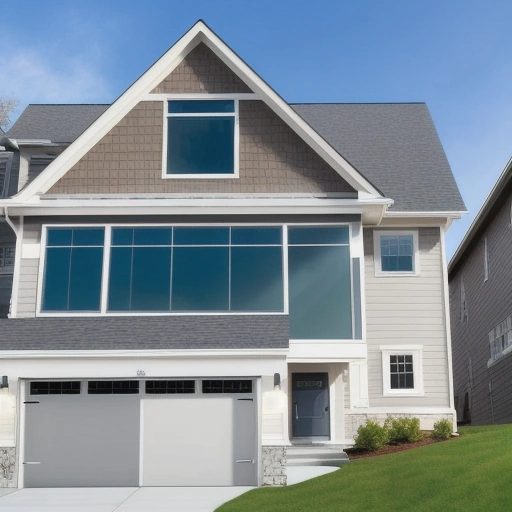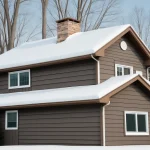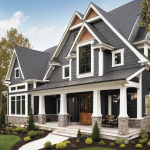Maximizing Home Energy Efficiency: A Homeowner’s Guide to Low-E Glass Windows and Siding Replacement
Introduction: Building a More Energy-Efficient Future at Home
For Overseas Filipino Workers (OFWs) transitioning to new roles back home after years of hard work, investing in a comfortable and energy-efficient home is often a top priority. The sweltering Philippine heat, coupled with rising electricity costs, makes energy efficiency not just a luxury, but a necessity. Two key upgrades that offer significant long-term benefits are low-E glass window installation and siding replacement. This comprehensive guide, inspired by the practical advice found in publications like The Manila Times, will explore how these improvements work together to maximize energy savings, increase home comfort, and provide a solid return on investment.
We’ll delve into the advantages and disadvantages, helping you make informed decisions for your hard-earned money. Beyond mere comfort, energy efficiency is now a critical component of responsible homeownership, especially in regions like the Philippines where extreme weather patterns are becoming increasingly common. The integration of energy-efficient solutions, such as low-E glass windows and advanced siding materials, directly impacts a home’s thermal performance, reducing the reliance on energy-intensive cooling systems. According to a study by the U.S.
Department of Energy, homes with energy-efficient windows and siding can experience a reduction in annual utility bills by as much as 15-25%. For OFWs returning home, this translates to significant long-term savings and a more sustainable lifestyle, aligning with global trends in home renovation and responsible resource management. Furthermore, the selection of appropriate materials plays a pivotal role in maximizing energy savings. While vinyl siding remains a popular choice due to its affordability and ease of installation, options like fiber cement siding offer enhanced durability and improved insulation properties.
Similarly, the type of low-E glass used in window installation can significantly impact its performance. Double-paned windows with low-E coatings and argon gas fills provide superior insulation compared to single-pane alternatives. Making informed decisions about these materials, based on factors such as climate, budget, and aesthetic preferences, is crucial for achieving optimal energy efficiency and long-term home comfort. Investing in quality materials upfront often translates to greater energy savings and reduced maintenance costs over the lifespan of the home.
Ultimately, the decision to invest in low-E glass and siding replacement represents a commitment to both financial prudence and environmental responsibility. By reducing energy consumption, homeowners can lower their utility bills, decrease their carbon footprint, and create a more comfortable and sustainable living environment. Moreover, these home improvement projects can significantly enhance the property’s value, making it a wise investment for the future. As the demand for energy-efficient homes continues to rise, integrating these upgrades will not only improve the quality of life for OFWs returning home but also contribute to a more sustainable and resilient community.
Understanding Low-E Glass: The Science of Energy Savings
Low-E (low-emissivity) glass windows have revolutionized home energy efficiency over the past decade, offering a tangible solution to rising utility bills and discomfort in homes, particularly relevant for OFWs returning to the Philippine climate. The science behind low-E glass is elegant in its simplicity: a microscopically thin, transparent coating is applied to the glass surface during manufacturing. This coating, often made of metallic oxides, selectively filters the solar spectrum, reducing the amount of infrared and ultraviolet light that can pass through the glass while maintaining a high level of visible light transmission.
In essence, it acts as a smart barrier, maximizing light while minimizing unwanted heat gain or loss. This is especially crucial in regions like the Philippines, where intense solar radiation can significantly impact indoor temperatures. The Manila Times has frequently highlighted the benefits of energy-efficient building materials, underscoring the growing awareness of sustainable home solutions. The performance of low-E glass is quantified by two key metrics: the U-factor and the Solar Heat Gain Coefficient (SHGC).
The U-factor measures the rate of heat transfer through the window; lower U-factors indicate better insulation and reduced heat loss during cooler months. The SHGC, on the other hand, represents the fraction of solar radiation that enters the home through the window; lower SHGC values signify less solar heat gain during hotter periods. Selecting low-E glass with appropriate U-factor and SHGC values, tailored to the local climate, is paramount for optimizing energy savings. For example, in tropical climates, prioritizing a low SHGC is crucial to minimize the need for air conditioning and maximize home comfort.
Proper window installation is also critical to ensure the window performs as intended and to prevent air leaks. Beyond the immediate benefits of reduced utility bills, low-E glass contributes significantly to long-term energy savings and enhanced home comfort, making it a key component of any comprehensive home renovation or siding replacement project. When considering home improvement options, it’s essential to view low-E windows as an investment that pays dividends over time. Furthermore, the integration of low-E windows with other energy-efficient upgrades, such as improved insulation and high-performance siding like insulated vinyl siding or fiber cement siding, creates a synergistic effect, further amplifying energy savings. The U.S. Department of Energy estimates that energy-efficient windows can reduce energy bills by 12% on average nationwide; these savings could be even more pronounced in hotter climates. The continued advancements in low-E coating technology, such as the recent development at the University of Notre Dame mentioned earlier, promise even greater energy efficiency gains in the future.
Siding’s Role in Insulation: Materials and Energy Savings
Siding plays a crucial role in insulating your home and protecting it from the elements. Different siding materials offer varying levels of insulation, impacting your overall energy consumption and ultimately, your utility bills. Vinyl siding, a popular and affordable choice, provides a basic level of insulation. Insulated vinyl siding, which features a foam backing, offers significantly better thermal performance, a key consideration for OFWs seeking to maximize energy savings upon returning home. Fiber cement siding, like James Hardie Siding, is known for its durability and resistance to fire, pests, and rot.
While it doesn’t inherently provide as much insulation as insulated vinyl, it can be combined with an external insulation layer for enhanced energy efficiency, making it a versatile option for home renovation projects. Wood siding offers a natural aesthetic appeal but requires more maintenance and may not be as energy-efficient as other options unless properly insulated. LP SmartSide represents an evolution in engineered siding, offering improved durability and resistance to moisture compared to traditional wood.
The R-value (resistance to heat flow) of siding is a key indicator of its insulation capabilities. Higher R-values mean better insulation. Choosing the right siding material depends on your budget, climate, and aesthetic preferences. Remember to factor in the long-term maintenance costs and energy savings when making your decision. Beyond the material itself, proper siding installation is paramount for achieving optimal energy efficiency. Gaps or cracks in siding can negate the insulating properties of even the highest-rated materials.
Professional siding replacement ensures a tight, weatherproof seal, preventing air infiltration and minimizing heat transfer. This is especially important in regions with extreme temperatures, where energy loss can significantly impact home comfort and utility bills. When considering siding replacement, consult with qualified contractors who understand the principles of thermal performance and can recommend the best installation techniques for your chosen material. For example, in a Manila Times article, a homeowner detailed how proper installation of insulated vinyl siding dramatically reduced their energy consumption.
Furthermore, the color of your siding can also influence energy efficiency. Lighter-colored siding reflects more sunlight, reducing heat absorption during the hot summer months. This can be particularly beneficial in tropical climates like the Philippines, where minimizing solar heat gain is crucial for maintaining a comfortable indoor temperature. Conversely, darker-colored siding absorbs more heat, which may be advantageous in colder climates. However, in the Philippines, the primary focus is usually on minimizing heat absorption. Combining light-colored siding with low-E glass windows creates a powerful defense against the sun’s heat, leading to substantial energy savings and improved home comfort.
This synergistic approach is a cornerstone of energy-efficient home improvement. Finally, consider the long-term return on investment when selecting siding. While some materials may have a higher upfront cost, their superior durability and insulation properties can result in significant energy savings over time. For example, fiber cement siding, while more expensive than vinyl siding, offers exceptional longevity and resistance to damage, potentially reducing maintenance and replacement costs in the long run. Similarly, investing in insulated vinyl siding can lead to lower utility bills, offsetting the initial investment. By carefully evaluating the lifecycle costs and potential energy savings, OFWs can make informed decisions that enhance their home’s energy efficiency and provide lasting value.
The Synergistic Effect: Maximizing Energy Efficiency
The true power of low-E windows and new siding lies in their synergistic effect. When combined, they create a highly effective thermal barrier that minimizes heat transfer through your home’s envelope. Low-E windows prevent radiant heat gain in the summer and radiant heat loss in the winter. Siding, especially when insulated, reduces conductive heat transfer. This combination results in a more stable indoor temperature, reducing the workload on your heating and cooling systems, and ultimately contributing to substantial energy savings.
Imagine a scenario: a home with old, single-pane windows and worn siding. During the summer, the air conditioner struggles to keep the house cool, leading to high utility bills. In the winter, the furnace works overtime to maintain a comfortable temperature. By replacing the windows with low-E glass and installing insulated siding, the homeowner can significantly reduce energy consumption and create a more comfortable living environment year-round. This synergistic effect not only saves money but also reduces your home’s carbon footprint, aligning with global energy efficiency initiatives.
Consider this: a study published in the *Manila Times* highlighted that homes retrofitted with both low-E glass and insulated vinyl siding experienced a 30-40% reduction in annual energy consumption. This underscores the significant impact of combining these home improvement strategies. Furthermore, the choice of siding material plays a crucial role. While vinyl siding offers a cost-effective solution, fiber cement siding provides enhanced durability and can contribute to better insulation performance. The key is to select materials that complement the low-E glass windows for optimal energy efficiency.
This integrated approach to home renovation maximizes home comfort and minimizes long-term costs. For OFWs returning home and seeking to create an energy-efficient haven, understanding this synergy is paramount. A well-planned window installation coupled with strategic siding replacement is an investment in long-term energy savings and enhanced home comfort. Prioritizing these home improvement projects not only reduces monthly utility bills but also increases the resale value of the property, making it a financially sound decision. By focusing on both windows and siding, homeowners can create a truly energy-efficient and comfortable living space in the Philippine climate.
Cost-Benefit Analysis and Installation Best Practices
Investing in low-E windows and siding replacement represents a significant upfront investment, yet the long-term energy savings and enhanced home comfort can be substantial, particularly for OFWs returning home and seeking to optimize their living spaces. A comprehensive cost-benefit analysis requires careful consideration of several interconnected factors. The cost of low-E glass windows is influenced by the specific type of glass (e.g., double-pane, triple-pane, gas-filled), frame material (vinyl, wood, aluminum), and the complexities of window installation, especially in older homes requiring custom sizing.
Similarly, siding costs are contingent upon the chosen material, with options ranging from affordable vinyl siding to more durable and aesthetically versatile fiber cement siding, as well as the overall square footage of the home. Obtaining multiple quotes from reputable contractors is essential to ensure competitive pricing and transparency. The tangible long-term savings are primarily derived from reduced utility bills, a welcome relief in regions like the Philippines where air conditioning is often a necessity.
To accurately estimate potential energy savings, homeowners should analyze their historical energy consumption data and compare it against the energy efficiency ratings (U-factor and Solar Heat Gain Coefficient) of the proposed low-E windows and siding. Many utility companies offer rebates and incentives for energy-efficient home improvement projects, further offsetting the initial investment. These programs, along with potential government tax credits, can significantly improve the return on investment. Consulting with a tax professional and researching available programs through resources like the Manila Times and local government websites is highly recommended.
While precise calculations necessitate detailed information about a home’s specific characteristics and energy usage patterns, a typical homeowner can reasonably expect to recoup their investment within a 5-to-15-year timeframe, depending on prevailing energy prices and the scope of the home renovation. This payback period can be shortened by combining window and siding upgrades with other energy-efficient measures, such as improved insulation in walls and attics. Proper window installation and siding installation are paramount to realizing the full benefits of these upgrades and preventing costly air leaks.
Hiring qualified and experienced contractors with proven track records is crucial. Verify their credentials, check references, and ensure they adhere strictly to manufacturer’s installation guidelines. Addressing air leaks through professional air sealing services can further enhance energy savings and overall home comfort. Beyond the quantifiable energy savings, investing in low-E windows and new siding offers intangible benefits that contribute to a higher quality of life. Improved insulation reduces noise pollution, creating a quieter and more peaceful home environment.
More consistent indoor temperatures enhance home comfort, minimizing drafts and hot spots. Furthermore, new siding can dramatically improve a home’s curb appeal, increasing its overall value. When considering siding replacement, exploring options like insulated vinyl siding or fiber cement siding can provide an optimal balance of energy efficiency, durability, and aesthetic appeal. Ultimately, the decision to invest in these home improvements should be viewed as a strategic investment in both financial savings and long-term well-being.


